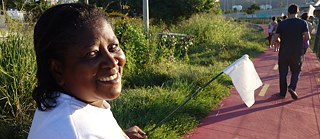Workshop
Vila retaken
On June 25th, artists and curators met once again with the inhabitants of Vila Autódromo. This is a summary and impressions of the second workshop.

The first signs were those of a fertile Vila, which offered us fruit.
Next to it, the church that resisted. San José Obrero, Catholic Church. Its structure is simple, although the frescoes of Saint Joseph are witness to a policy of zeal and caution. Some residents were already waiting for us there, sitting on benches. It immediately became clear that the local parochial agenda goes much more than address religious affairs. This is the inhabitants' meeting point, their little cafe, their thrift store, and their possible connections. I hear from Sandra that they also used it to store their furniture and belongings during the removals. Father Fabio, who coordinated the place, was one of the central figures of resistance throughout the process, which garnered him a place in the Vatican. This Sunday, however, we were to act outside. We all headed toward the front of the church, in a circle. Kammal and Iazana took the lead with a first process of awareness-raising. A round of names: Dalva, Denise, Baiana, Sandra, Shana, João, Luisa, among others. Paying attention to breathing. Then, small steps, recognizing the space, going, touching each other's shoulders, their head, all of them still shy, recognizing each other. The typical initial introversion, between timidity and silence, was making way for the exchange.
So we went back to the church. The benches, occupied a few minutes before by more disciplined bodies, seemed a little more comfortable now. There we lay down. Our eyes were closed. Yazana and Kammal were narrating a kind of relaxation to elicit sensations and reflections in the body and in the ideas based on each person's path. Meanwhile, they spread clay on our bodies. The ice-cold bits were shaping themselves anatomically on our knees, forehead, belly, neck... We began then to manipulate them, putting in them—according to Iazana's guidelines—all of our accumulated sorrow, resentment, and energy. As we all know, clay has an absorbent quality.
We went out again. Marking the Vila, the demarcation of its legitimate existence for the rest of the city, is a recurrent demand of the inhabitants. We would, therefore, make a first outline of that. With small flags in raw fabric, made by Kammal, we organized a procession. We remained together in a group, each person carrying their own flag, up to a patch of grass near the road. There, Kammal presented a series of words taken from a letter written by the inhabitants. Each person had to choose two of them and write them on their flag. Thus, couplets emerged, such as: "fight and union," "dialogue and reality," "rights and housing," "[we] continue and urgency," among others, stuck slowly at the foot of a tree, near some new seedlings, on the edge of the road or, as in the case of Dona Dalva, in the place where her house used to be.
The administration of memory in this place is something very peculiar. Denise, for example, does not like to evoke memories. She is always gentle with us, but would rather turn the page. Dalva is always talking about minutiae of an old Vila, the custom of placing a chair on the road on hot days; the capybaras that came by in search of company; birthdays, a neighbor... Penha and Sandra, on the other hand, assume a more openly political stance, articulating strategies for the resistance, recognition, and organization of the group. There are many singularities inhabiting a set of apparently identical houses (a lesson of the condos), that are customized little by little with colors, plants, objects on the lawn, all kinds of resources and subjectivities.
In our case, as novice visitors, thinking up strategies of communication requires some caution. These are months of visits, conversations, and introductions. Still, the demarcation of differences always persists. Plus, having a delicate background, sometimes some maintain a state of distrust, as if they still speculated about our movements and intentions. This is absolutely understandable, and maybe that's the reason for the need to resort to practices of awareness raising, workshops, and group dynamics that burst into the hegemony of an objective or linear discourse. It is the attempt to create the bond that will effectively let us think together, try together, and solve together.
The second signs are those of a firm Vila, a Vila undergoing reconstruction.